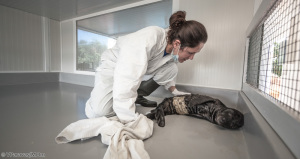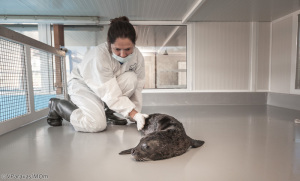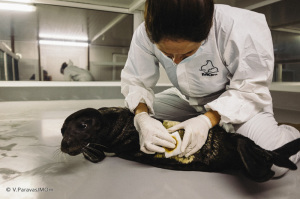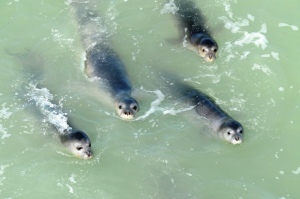 This year has seen the best monk seal breeding season since 1997 at Cabo Blanco, Mauritania. The colony stands now at around 250 individuals, marking an ongoing recovery from the mass die-off in 1997, which saw the 300 strong population plummet by two thirds. Continue reading “IUCN – Best breeding season yet for Mediterranean Monk Seal colony”
This year has seen the best monk seal breeding season since 1997 at Cabo Blanco, Mauritania. The colony stands now at around 250 individuals, marking an ongoing recovery from the mass die-off in 1997, which saw the 300 strong population plummet by two thirds. Continue reading “IUCN – Best breeding season yet for Mediterranean Monk Seal colony”
Rescue of an orphaned monk seal pup on Skopelos
MOm – press release, 18 November 2014
On Saturday the 15th of November, MOm’s Rescue Team was informed by Mrs Niki Lemoni, member of the Veterinary Network of ARION, Cetacean Rescue & Rehabilitation Research Center, that a newborn female Mediterranean monk seal was stranded orphaned in Velanio beach at Skopelos, Northern Sporades.
Continue reading “Rescue of an orphaned monk seal pup on Skopelos”
Note on an old female monk seal that died in Croatia in 2014
by Prof. Dr Đuro Huber, Biology Department, Veterinary Faculty, Zagreb, Croatia
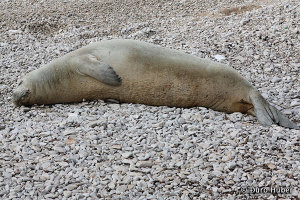 The individual concerned was photographed for the first time on 08 March 2009 by the Monk Seal Group (Jasna Antolović, chair) in the Nature Park Kamenjak at the tip of the Istria peninsula. Confirmed sightings of the monk seal in the area started already in 2004. However, at that time the animal did not have the distinguishable scars on the base of the neck and the base of the hind left flipper. It can be stated that this animal stayed in the area at least for five years and probably almost for 11 years. Automatic cameras pictured her on many occasions in the meantime, but she was also seen several times around the island of Cres, as well. Continue reading “Note on an old female monk seal that died in Croatia in 2014”
The individual concerned was photographed for the first time on 08 March 2009 by the Monk Seal Group (Jasna Antolović, chair) in the Nature Park Kamenjak at the tip of the Istria peninsula. Confirmed sightings of the monk seal in the area started already in 2004. However, at that time the animal did not have the distinguishable scars on the base of the neck and the base of the hind left flipper. It can be stated that this animal stayed in the area at least for five years and probably almost for 11 years. Automatic cameras pictured her on many occasions in the meantime, but she was also seen several times around the island of Cres, as well. Continue reading “Note on an old female monk seal that died in Croatia in 2014”
A new sighting of the Mediterranean monk seal in the Marmara Sea
Recent Publications
![]()
Özgür Emek Inanmaza, Özgür Değirmenci and Ali Cemal Gücü. 2014. A new sighting of the Mediterranean Monk Seal, Monachus monachus (Hermann, 1779), in the Marmara Sea (Turkey). Zoology in the Middle East, 60 (3): 278-280. DOI:10.1080/09397140.2014.944438
[…] In total six caves displaying Monk Seal resting/breeding characteristics (see Karamanlidis, Pires, Silva, & Neves, 2004; Gucu, Gucu, & Orek, 2004) were discovered. There was clear evidence in one of those cases, namely the peculiar odour and tracks on the inner sandy beach, and this indicated the recent presence of a seal in the cave. The cave had a surface opening with an inner area and a platform formed by sand, pebbles and large boulders. During the surveys, seals were sighted at four different occasions on 21 April, 27-30 May and 14 June 2014, and were recorded on a video. […]
New report on monk seals of Gyaros, Greece
Recent Publications
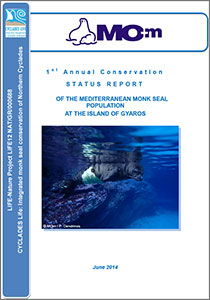
MOm. 2014. 1st annual conservation status report of the Mediterranean monk seal population at the island of Gyaros. 1-30. [PDF 1.5MB]
[…] Annual pup productivity
The minimum mean annual number of births (n = 7.75) recorded at the island of Gyaros is one of the highest recorded for the species in the Mediterranean Sea and could be higher if systematic assessments of natality were conducted throughout the breeding season at each site in the years 2004 – 2011. Systematic surveys of annual pup production at Cabo Blanco in the Western Sahara (González et al., 2002), the Northern Sporades, Kimolos & Polyaigos, and at Karpathos & Saria (MOm, 2007) yielded counts of 25.0, 8.4, 7.9, and 3.7, respectively. […]
Tourism could help save Mediterranean monk seals, but if unmanaged it will only accelerate their demise
Giuseppe Notarbartolo di Sciara
 […] Unfortunately, the monk seal breeding season happens to coincide in part with the peak of the tourist season, a coincidence likely to result in making the seals even more endangered than they already are, as I had the opportunity of documenting yesterday in an undisclosed location of the Northern Dodecanese, in Greece. Continue reading “Tourism could help save Mediterranean monk seals, but if unmanaged it will only accelerate their demise”
[…] Unfortunately, the monk seal breeding season happens to coincide in part with the peak of the tourist season, a coincidence likely to result in making the seals even more endangered than they already are, as I had the opportunity of documenting yesterday in an undisclosed location of the Northern Dodecanese, in Greece. Continue reading “Tourism could help save Mediterranean monk seals, but if unmanaged it will only accelerate their demise”

